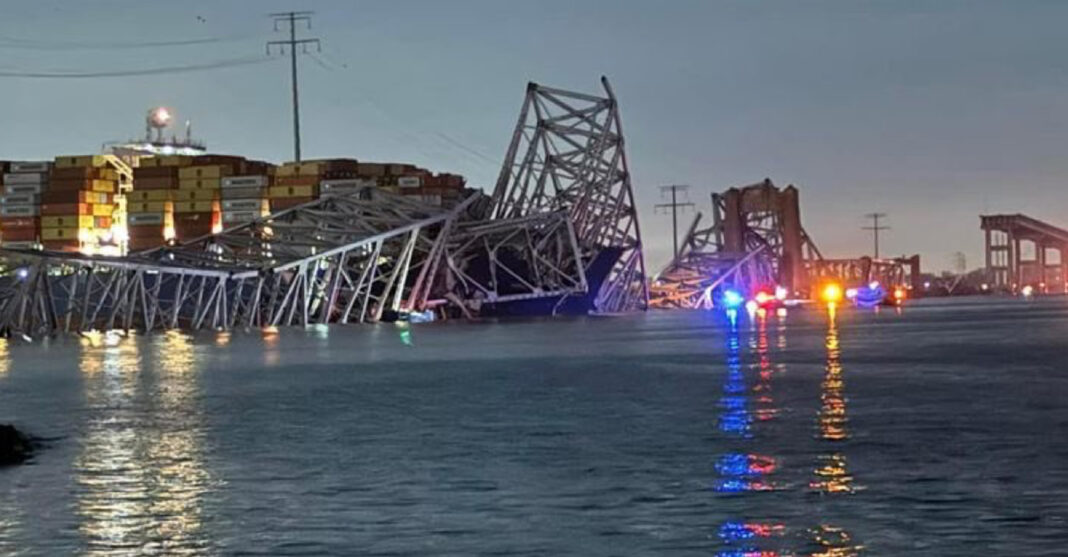As you know a massive container ship struck a support of the Francis Scott Key Bridge in Baltimore and seconds later the entire structure collapsed. Initial concerns about terrorism proved unfounded. It was an accident. An awful one to be sure but an accident. However it was a foreseeable one as I’ll explain. Would-be Senator Hogan is demanding the federal government pick up the entire tab to cover the massive costs ahead. He wants everyone to overlook it was via his efforts (and against sound advice) that such massive ships were able to use the port in the first place!
Perhaps you think it’s tasteless to do so (and maybe it is) but with control of the Senate hanging in the balance this November it’s a discussion that needs having. But the ugly fact is that former (and quite popular) Governor Larry Hogan who is now a candidate for Maryland’s open Senate seat is going to have some explaining to do. If not for considerable effort on his part huge ships like the one that caused the collapse of the Key Bridge would never have been near it because the Port of Baltimore at one time couldn’t be reached by them. Or dock and unload/reload them. Again it seems crass to inject politics into this mess but that just how things are now so let’s talk politics for a moment.
By any measure Democrats who hold a slim majority in the Senate were facing a tall task to retain control. The Senate map strongly favored Republicans and even post Dobbs has remained in their favor. Even had Democrat Joe Manchin run for re-election in bright red WV he wouldn’t have won. That’s why he retired. So that seat was gone regardless leaving things split 50-50 and at best (it seemed) another “power sharing” for at least two years. With a Kamila Harris as VP we’d have the upper hand on legislation but the committee process would be junked up. However, the GOP had (and still does) pickup chances in other states. Ohio and Montana in particular. Sherrod Brown and John Tester have proven able to beat back challenges in those red states but both races are cause for concern.
Maryland is an open seat due to retirement of Ben Cardin but it’s a solid blue state and seemed safe. At least until Mitch McConnell convinced former Governor Larry Hogan to throw his hat in the ring. Yes, it’s a blue state but like Massachusetts has a history of sometimes electing a Republican Governor. Hogan was well liked, even popular when he left office. No Labels tried like hell to recruit him and he politely told them no thanks and to leave him alone. He seemed to enjoy his status and to not have any interest in the rough and tumble of elective politics. Just being a pundit seemed to suit him. I thought the ONE thing that might draw him back was an implosion of Trump before the GOP convention, and Hogan might be able to swoop in to save the Party. Assuming it wanted to be saved from not just Trump but Trumpism.
Ole Moscow Mitch has spent a lot of time lamenting the quality of Senate candidates in recent times but in Hogan he saw a golden opportunity. Eventually he convinced Hogan to get back into the game, and all of a sudden what seemed like a safe retention of Cardin’s seat by Democrats has been up for grabs. Maryland of all places could be the magic state for McConnell. The one that could, if Democrats can hold serve elsewhere tips the balance back to the GOP. Until now, and that tragic shipwreck that has collapsed a major bridge. And, in the process shut down a major traffic artery and one of the busiest ports in the U.S. The ripple effects of the disaster will be felt far outside Baltimore and the state of Maryland. It’s going to affect the entire country.
So you ask what does all this have to do with GOP Senate candidate Larry Hogan? I refer you to an article by Jacobin which lays it all out. It’s detailed and takes a bit of time but well worth reading. As it turns out while he was Governor, Hogan championed steps that allowed such massive ships to go in and out of the Port of Baltimore. Despite warnings of the potential for disaster! The linked article starts out in language that has to be making Hogan (and McConnell) cringe, speaking to his flouting safety warnings. To specifically attract huge ships like the one that crashed into the Key Bridge into Baltimore. Hogan ignored warnings from transportation experts and even a giant insurer, pledging to Marylanders that bringing in every larger ships would strengthen the local and state economy. And even improve safety:
His administration’s major public-private partnership to attract such mega-ships promised that it “reduces the occurrences of crashes, fatalities and injuries among transportation users.”
Hogan appointed the head of dredging contractors’ lobbying group to run the port amid the much-celebrated expansion that doled out lucrative dredging and construction contracts.
If that’s not enough then consider this:
As the insurance conglomerate Allianz was spotlighting the dangers of large cargo ships, Hogan positioned himself as his state’s highest-profile supporter of the mega-ship industry — at one point declaring that thanks to his administration’s investments, “every year we are seeing larger and larger container ships choosing the Port of Baltimore.”
It turns out the experts were right and Hogan was wrong. Now, six people are dead (thankfully swift and effective action was taken due to a a prompt “Mayday” call from the ship or many more lives would have been lost), upwards of eight thousand people are out of work and tens of thousands more in and around Baltimore are affected due to that bridge being gone. It’s also a major traffic artery for traffic going up and down the east cost which means the trucking industry will have to reroute huge amounts of goods. And then there’s going to be the massive cleanup and rebuilding costs. Yep Larry, your cronies in the business world made out like bandits and ultimately tens of millions (at least) Americans will pay the price in increased costs of goods due to that bridge being down and the port being closed, perhaps for months.
Back in 2015 two different and significant entities issues reports warning about what’s happened in Baltimore happening. Hogan, as you’d expect a pro-business Governor to do blithely ignored them. You’d think since one was from a major insurance carrier he’d have at least exercised some restraint:
“Ship size growth raises risk management concerns,” warned a report that year from insurance giant Allianz. “Larger ships could also mean larger losses. . . . Maximum exposure will not necessarily be limited to vessel and cargo value but could also include environmental, social or business interruption backlash.”
Gee, ya think? In the months ahead, with the GOP already hoping for the economy to tank the disruption is as I’ve stated going to be felt far and wide. Then there will be debates over the costs of the cleanup and re-opening of the port alone. A new bridge? The days of Congress joining together and passing a large funding measure like it did to rebuild the I-35 Bridge in Minneapolis are long gone. GOPers are already saying hell no, or demanding offsets in other government spending. I’m suuuuure Baltimore having such a large black population, a black mayor and Maryland being a Democratic state, and again with a Democratic Gov. who is black has nothing at all to do with it!
Anyway, in 2015 another institution published a report that went unheeded:
In a report published that same year by the International Transport Forum, a consortium of sixty-six governments, researchers wrote, “The costs to salvage hulls of [the] largest existing containerships in case of accident will increase because of the lack of salvage equipment and technology capable of removing a wreck of this size.”
The International Transit Forum report explicitly warned cities against using public money to retrofit ports to encourage larger ships.
However Hogan, elected in 2014 championed expanding the port’s capabilities. Unfortunately the Key Bridge wasn’t a priority for him:
The Hogan administration’s 2018 port-expansion application included implementing safety requirements for dredging the channel, widening the space needed for these boats’ turning radius, and fortifying the wharf structure, among other considerations. But it did not make any adjustments or designate protections for the nearby Key Bridge, which the ultra-large crafts would be traveling under
As the expansion project for the port neared completion Allianz sounded yet another warning that went unheeded:
“While approach channels to existing ports have been dredged deeper and berths and wharfs extended to accommodate ultra large vessels, the overall size of existing ports has remained the same,” wrote one of the insurance company’s senior marine risk consultants. “As a result, ‘a miss’ can turn into ‘a hit’ more often for the ultra large container vessels.”
The concern about the Key Bridge which opened in 1977 isn’t new. In fact all the way back in 1980 a bridge crash down in Florida took thirty-five lives. A top state engineer told the Baltimore Sun the Key Bridge couldn’t survive a similar hit. Keep in mind back then ships were much smaller that routinely would come to pass under that bridge. Also keep in mind that while this was a large ship larger and heavier ones have done the same to enter and leave the Port of Baltimore. Also keep in mind that ships this size, even at low speed can’t be stopped in only two or three hundred yards, even with working engines thrown into “crash stop” mode. It might take up to a couple of years but the NTSB will no doubt come up with recommendations to reduce risks of a similar catastrophe and not just in Baltimore. And both shipping companies and even some local governments, especially with conservative leaders will howl in protest.
In the meantime we have a former Governor who ignored warnings from not gadfly groups but large and respected institutions. Had then Gov. Hogan heeded at least to some degree those warnings we might not be looking a a costly, both in dollars and lives disaster. Hogan is now a Senate candidate. A Republican Senate candidate and as he calls for the federal government (which means your tax dollars and mine) to pay the entire tab for this disaster if elected he’ll join colleagues who want no such thing. Or will insist on cuts in other parts of the federal budget to pay for cleanup and rebuilding. The last thing he will want is for people to take a look, much less a close one at his role in fomenting this disaster.
So yes, Larry Hogan has some explaining to do. A LOT of explaining. The more his fellow Republicans try to stick the state of Maryland with the tab, the less popular Hogan will get as we move towards election time. Hence the title of this piece, because that ship might have taken out Larry Hogan’s Senate chances just like it took out the Key Bridge.





















Impeccable timing. Republicans will grab any negative economic impact this has. Just when things were improving for Biden. Don’t be fooled.
How can these people be so nakedly corrupt? They don’t even try to avoid the appearance of impropriety.
Hogan’s administration’s major public-private partnership to attract such mega-ships lied in promising that it “reduces the occurrences of crashes, fatalities and injuries among transportation users.”
Hogan then appointed the head of the dredging contractors’ lobbying group to run the port amid the much-celebrated expansion that doled out lucrative dredging and construction contracts.
At the very same time that the insurance conglomerate Allianz was spotlighting the dangers of large cargo ships, Hogan positioned himself as his state’s highest-profile supporter of the mega-ship industry — at one point declaring that thanks to his administration’s investments, “every year we are seeing larger and larger container ships choosing the Port of Baltimore.”
So despite clear warnings from experts, he appointed the person most likely to benefit from dredging the harbor into deciding whether the harbor needed dredging!
Yet again a decision made by self interested republicans results in a disaster that they won’t have to pay for, after they took an excessive risk that they were EXPLICITLY warned about!
And who pays for it? Lives lost won’t bother their consciences, (pah! immigrants!) and the vast economic cost of replacing the bridge and the lost economic activity won’t be paid by them either.
Everyone else pays in the usual big business republican model of privatising profits and socialising costs.
I gotta bridge to sell you to nowhere is one of the oldest trick in the books. As usual the people fall for it!
I was on the crew of a Navy auxiliary oilier for three years. The only docks we could tie up to were in the US or at Navy bases. Every where else we had to anchor out and we damn sure had to have tugs with a qualified pilot running the show. I could not believe that big ass ship was going into or out off port without tugs and pilots. Once while on a smaller ship the captain decided we would go from the supply pier in Pearl Harbor to our normal birth under our own steam. Only one of two propellers was working thus we couldn’t use them for steering as was normal. We ended up plowing nose first onto a muddy beach on Ford Island. Unlike Baltimore it was hilarious. I went out on the weather deck and watched the tugs slam into the starboard bow till they pushed us off the mud.
It seems like common sense that a set of tugs would be stationed at certain points in the approaches to ports, especially near bridges just in case a large ship were to have problems. Of course, it would cost money to do that and even though the costs could be shared, say by part of the docking fees (which could be increased using a formula based on size and tonnage of ships a carrier sends in and out of ports) but the shipping companies would scream bloody murder. And hire lobbyists who would in turn kill legislation from the local level all the way up to Congress. Maybe that will change.
People might think I’m suggesting something extreme but ships DO sometimes encounter problems. As I noted the Key Bridge accident isn’t the first time a major crossing has been struck by a large ship. Even a small cargo ship can, operating at a higher speed do a lot of damage. But a fully loaded cargo ship of medium or larger (and this one seems massive but it’s not even a thousand feet long) even at low speed hits with tremendous force. Easily enough to cause a major support to fail and with it a large portion of even a major bridge. Or at least do so much damage the bridge would be unsafe and could take as much as a year to repair.
Most people reading this don’t understand the forces involved. In this case we are talking about a ship a little smaller than an aircraft carrier but in the same general weight/tonnage. If I were to ask any of you how long it would take and how much distance for a ship that size to come to a full stop you’d probably guess 15-20 seconds and two to four hundred yards. In reality, even at the slower distances a large container ship would be at in relatively confined waters you’d be looking at eight to ten MINUTES and several or more MILES. That’s assuming power/engines are operating and can be thrown into full reverse. Likewise ships that size can’t by themselves turn on a dime. Without a tug(s) pushing the turning radius exceeds a mile!
Without any help at the ready from a tug or two there was nothing the crew could do when the ship lost power except what they did. Issue an immediate Mayday call in case the ship drifted into a bridge support. So yes, I think shippers should pony up the costs of having a small fleet of tugs operating round the clock. They’d seldom be called upon to actually take action to push a ship away from a disastrous collision but ships DO sometimes have problem in constricted places and in a world of “just in time” delivery even small disruptions cause wide ripple effects and cost both shippers and consumers. And sometimes lives.
I watched a video where an engineer explained that the disaster could have been averted by the installation of “dolphins”, concrete pilons that would stop a large vessel from reaching the superstructure pylons. I guess they were looking to cut costs and thought only about dredging the port and expanding the docks for larger vessels, not taking into account what could happen if one hit a bridge pylon.